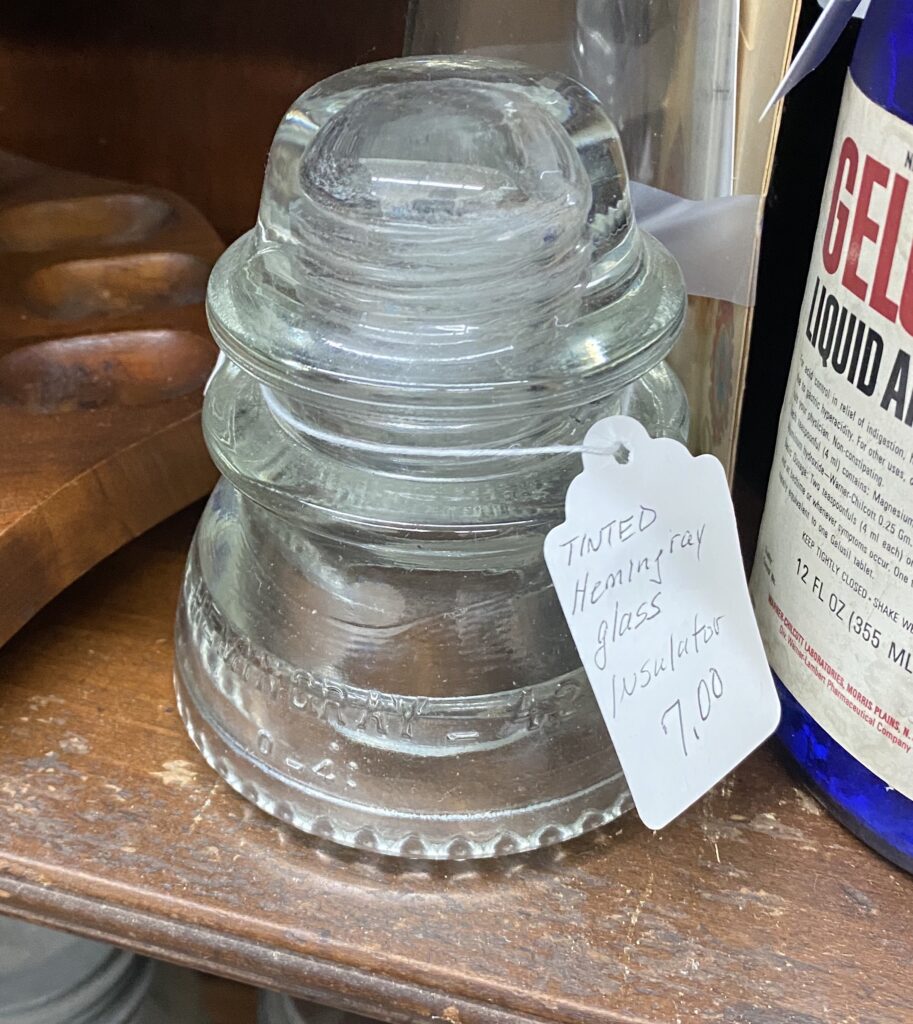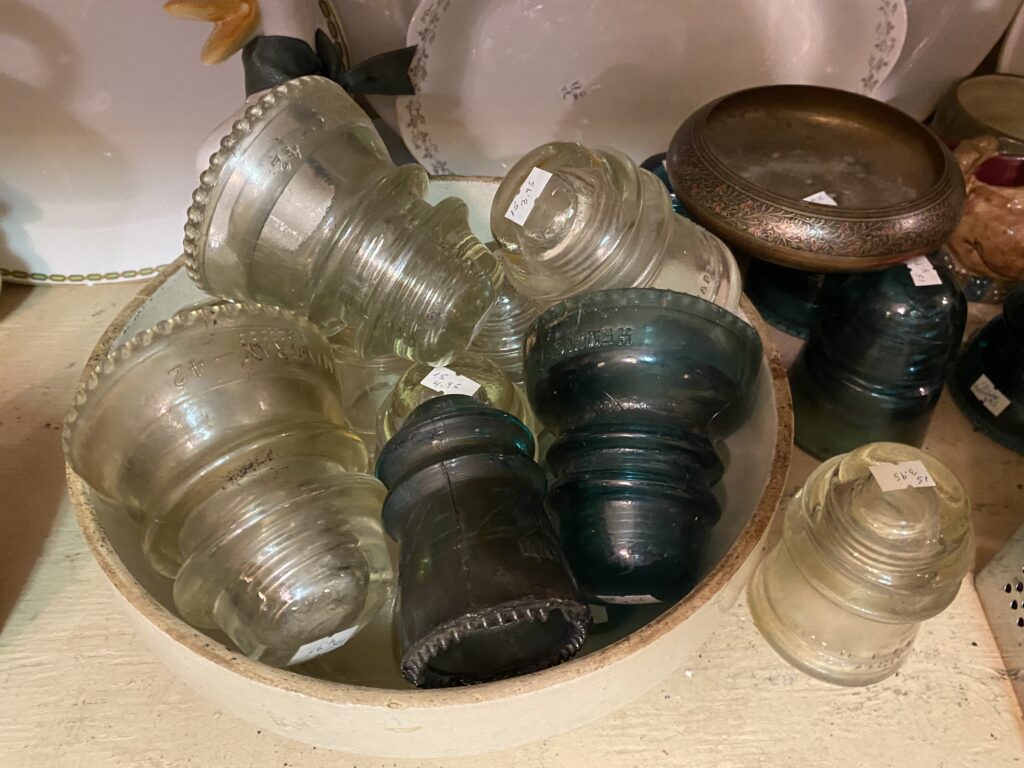Billions of glass insulators were produced from the mid-19th century to the mid-20th. Within the industry, there was a long list of manufacturers, but only a few companies stood out as leaders. Hemingray Glass Company was definitely one of them.
Hemingray, by 1937, had produced a billion insulators in their own right. Today, many of those insulators can still be found on the market. One of their most common insulators, both produced and widely available today, is the Hemingray-42. The company also produced rarer models such as the “Mickey” or “Provo” types. While a clear glass Hemi-42 can sell for a couple of dollars, Provos can fetch over a thousand bucks in bidding wars.
But where did this company so epitomic to glass insulators come from and how does its legacy of durable products live on? Read on to find out more about Hemingray Glass Company’s history, models, and current uses.

How Old is a Hemingray Glass Insulator?
The company that would become Hemingray Glass Company, Inc. was originally founded in 1848.[1] Two men, Robert Hemingray & Ralph Gray, were at the helm of this Cincinnati-based start. A number of company names using both last names were cycled through two decades before the company was incorporated under the familiar name in 1870.
By 1888, the company had moved across the river to Covington, Kentucky before moving the production site again, this time to Muncie, Indiana. The area had attracted a fair amount of industry, largely iron and steel foundries, after natural gas deposits were discovered. Another glass company had moved in as well, right across the street from the Hemingray factory.

Interestingly, with no sand nearby, both companies ended up sourcing from the same sand dune, Hoosier Slide, about 170 miles away. With the same impurities in their mixtures, they produced nearly identical shades of glass from the 1890s to 1920 (when the dune was exhausted)— “Hemingray Blue” & “Ball Blue”. [2] For insulators, this deep blue coloring is only associated with Hemingray, who was producing 50 million insulators annually by 1907.[3]
Hemingray Glass Company was bought by Owens-Illinois in 1933. This wasn’t the only change of the 1930s: a new embossing system and a focus on productions in clear glass were introduced as well. In 1937, the billionth Hemingray insulator was made. Insulators continued to be produced at the Muncie factory under the Hemingray name until 1967. (The factory produced TV screens for another five years before fully shutting down.) In the end, Hemingray insulators were produced from the 1850s until over a hundred years later in 1967.[4]
How do you Date Hemingray Insulators?
There are a few broad categories for dating Hemingray insulators. Hemingray Blue was produced for only 30 years of the company’s timeline. That can be further narrowed to a span of six years, after 1914, if the insulator is in Hemingray Blue and has a “Made in U.S.A.” embossing. An international trade agreement came into effect requiring products sold internationally to be labeled with their country of origin.[5] After 1934, the majority of Hemingray insulators were primarily produced in clear glass.
In the same year, a new embossing system was introduced—used for the remainder of Hemingray production, it allows the insulator to be tracked to the exact year of production. An “O” for Owen-Illinois had been added the previous year but starting in 1934 a dash and single digit were added after to count the years since 1930. An insulator marked “O-5” would have been produced in 1935.

The system, threatening cumbersomeness with the approaching decadal change, was changed again in 1939. A dash between a double-digit for the model number and a double-digit indicating mold year was embossed with dots either around the dash or after the numbers to denote how many years after the mold year the particular insulator was produced. For instance, an insulator with the notion, “42-42 :” would be Model #42, cast in 1944 from a mold made in 1942.
However, none of this information covers the first fifty years of Hemingray production. For that, visual identification of model types is the best starting point. Here are twenty, in order of starting production, of Hemingray’s most common insulators:
- Standard (pre-model number): 1870s-1910s
- #15, 1870s-1933
- #4, 1880s-1910s
- #14, 1880s-1956
- #18, 1880s-1930s
- #19, 1880s-1940s
- #20, 1880s-1940
- #21, 1880s-1930s
- #9, 1890s-1940s
- #12, 1890s-1940s
- #16, 1890s-1920s
- Patented 1907 (patent date instead of model number), 1907-1920s
- #40, 1910-1921
- #16, 1919-1960s
- #42, 1921-1960s
- CSA, 1930s-1950s
- #45, 1938-1960s
- TS, 1940s-1960s
- #19, 1940s-1960s
- #9, 1950s-1960s[6]
What Were Hemingray Glass Insulators Used For?
Hemingrays, like most vintage glass insulators, were used for a wide range of telegraph, telephone, and electrical wiring. The list above includes insulators used for long range wiring; secondary power distribution, like to secondary circuits or consumers[7]; telephone lines; telegraph lines; rural lines; and transposition, or switching the line conductors’ physical position to improve transmission.[8]
A number of Hemingray insulators were noted while they were still in use on lines, here are a few examples:
- Hemingray-42s, one of the most familiar models, were found lining an “electric wall” of sorts along a railroad line in 2001. The purpose was unusual: if a rock fall disturbed the line, the electric relay would raise an alarm in order to warn trains in the area to proceed with caution instead of full speed ahead.[9]
- Hemingray-17s were discovered along a rural fence line in the Midwest in 1993, serving as a telephone line. Interestingly, since #17s were a later production (1950s-60s), these insulators would have been relatively young at this point.
- Conversely, a line utilizing Provo No0 insulators was found to still be intact in 2020[10] (and can still be viewed on Google Maps Street View[11]) along Hillis Street, Youngwood, Pennsylvania. The patent for Provo No0 was issued April 25th, 1899, and they were only produced for about a decade, so these insulators have most likely been in use for over 100 years.[12]
For the few insulators still in use, many more Hemingrays are in circulation as collectables or, as in the case of the profuse Hemi-42s, often repurposed for eclectic décor pieces.
Are Hemingray Insulators Worth Anything?
Hemingray insulators are worth anywhere from $2 to thousands of dollars, depending on type. Several Hemingray models are so familiar that it’s the glass coloring or mixture that often drives prices up. But clear Hemi-42s, as one of their most mass-produced styles, are easily purchased for under $10.[13] By comparison, a fancy glass style can go for $250-300[14], or even over $400 if it’s particularly desirable, like Cobalt Blue specimens.[15] Rare designs, like Provos or even unidentified styles with the Hemingray embossing, can go for over $1000.[16]
Hemingray was a profuse manufacturer with billions of glass insulators produced. The wide range of designs, embossing, & glass types left behind a visually dazzling array of vintage glass insulators … so much so that some collectors specialize in Hemingray glass alone. Whether they fit your style better on display or as a nouveau-chic light fixture, Hemingray vintage insulators are sure to be able to find their niche for years yet to come.
[1] https://glassbottlemarks.com/hemingray-glass-company/
[2] https://hemingray.net/articles/hemingray-blue/
[4] https://www.insulators.info/articles/hemi100.htm
[5] https://hemingray.net/articles/hemingray-blue/
[6] https://www.hemingray.info/database/top20.php
[7] https://scholarworks.calstate.edu/downloads/v118rd60v
[8] https://circuitglobe.com/transposition-of-conductors.html
[9] https://www.insulators.info/service/154fence.htm
[10] https://www.insulators.info/service/provo.htm
[11] https://www.google.com/maps/@40.232999,-79.5837353,3a,37.5y,280.62h,123.69t/data=!3m7!1e1!3m5!1sZMaKMZCY5UpXxc_TwXaWiA!2e0!5s20201101T000000!7i16384!8i8192?hl=en
[12] https://www.hemingray.info/database/detail.php?id=249
[13] https://antiques.lovetoknow.com/antique-glass-china/hemingray-42-history-value
[14] https://www.billandjillinsulators.com/auctions/149/summary.php
[15] https://www.jacquelinestallone.com/most-valuable-glass-insulators/
[16] http://www.greatestcollectibles.com/expensive-insulators-sold-ebay-october-2013/

